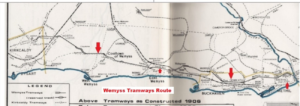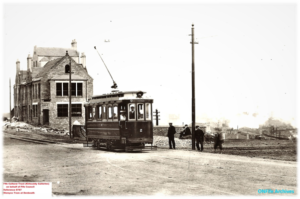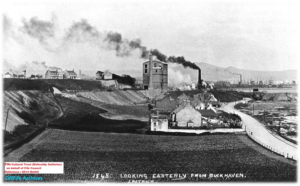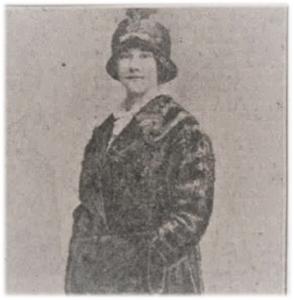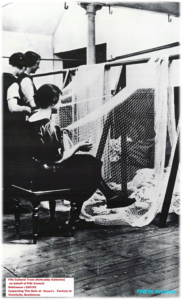Wemyss Parish, particularly the new burgh of Buckhaven, Methil and Innerleven, had taken major steps forward in the years after Robert and his family left for Overton Road and the Pathhead and Sinclairtown areas.
During this period of expansion, the Dunsire family name was part of the fabric of Buckhaven, Methil and Innerleven, through the various public and church roles and positive contributions of his uncles, Robert and Peter, had made to their growing community. Robert was surrounded by very positive influences. Their contributions and activity were well documented in the local Buckhaven and Kirkcaldy press, so Dunsire was a known family name in those areas.
His Uncle Robert was also a well-known choirmaster in Buckhaven. When he left Buckhaven in late October 1913, to settle in Manitoba, Canada, the local newspapers noted that he had been the choirmaster at St David’s church for nearly twenty-five years. Prior to that, he had been the choirmaster at Muiredge church for eight years. His son, Peter, remained behind in Buckhaven. He took up his father’s baton at St David’s Church and only retired from his role as their choirmaster in May 1934, after working with both junior and adult choirs. His retiral brought an end to the family dynasty at St David’s Church choir after a grand total of forty-five years.
The musical Buckhaven Dunsires were a force for good for a receptive and young Robert Dunsire. So, when he eventually moved along the coast, Robert became leader of the Buckhaven PSA Orchestra. Robert’s life influences had breadth and depth.
When Robert moved to work at the Rosie Pit at East Wemyss the journey from Kirkcaldy had been simplified by the opening, in 1906, of Wemyss Tramways, which ran between Gallatown and Scoonie in Leven. It connected with the Kirkcaldy Corporation trams at Gallatown giving 45 minutes’ access time to the mainline station in Kirkcaldy from Leven. In its first fortnight, the Wemyss Tramways carried 58,000 passengers.
Apart from the new housing created by the Wemyss Coal Company in Denbeath, the White Swan Hotel was built (pictured below in development, fronted by a Wemyss Car). The Savoy Skating Rink was built behind the Gaiety Theatre opposite the hotel at the top of Swan Brae. Wemyss Brick Works sat alongside the Wemyss Private Railway line that ran towards Wemyss from the Wellesley Colliery.
Attr: Fife Cultural Trust (Kirkcaldy Galleries) on behalf of Fife Council
Denbeath, now known as Wellesley Colliery, was now run by the Wemyss Coal Company rather than a lessee and had an additional shaft and a power station that also supplied Wemyss Tramways. The new Randolph Wemyss Memorial Hospital for the miners and the community opened and had a link directly under Wellesley Road from the pit. The hospital still provides NHS Community Services 100 years later. Finally, there was a new school at Denbeath. It was an imaginative and productive transformation in a twenty-year period since Robert’s birth in 1891.
Attr: Fife Cultural Trust (Kirkcaldy Galleries) on behalf of Fife Council
In parallel with the building of housing and community facilities and the opening of Wemyss Tramways, the Wemyss Private Railways expanded to provide a rail system opened in May 1887 and integrated the local pits with Methil docks, as well as with the mainline North British Railways (NBR) infrastructure. NBR bought the docks from Wemyss Coal Company in 1889. The above photo shows the area towards Denbeath, Denbeath Colliery and Methil Docks that was purchased and to be further developed by Randolph Wemyss
All of the above infrastructure came together to form an integrated transport system for the movement of goods, coal and people, including pit employees, who had specific trams set aside to ensure transport availability from a wider commuting area.
Randolph Wemyss had inherited his father’s estate in March 1864 but only completely took over at the age of 21 in July 1879. Randolph Wemyss was a canny operator and conscious of his own social responsibilities as the Estate developed mining operations and the railway system as he providing ample housing for employees following the development of Methil No. 1 Dock, and implemented plans for the Wemyss Tramways.
The Assets of Messrs Bowman & Co. came back under the control of the Wemyss Coal Company on 1 August 1905, when their leases expired. These included the Muiredge and Rosie Collieries, whose employees were retained by Wemyss.
Was it all of these changes that attracted 21-year-old Robert Anderson Dunsire to move back to the area of his birth for work? Or was it the attraction of a young worker, Kate Pitt (pictured below), who lived with her parents in Denbeath and was employed by one of the net manufacturers in Buckhaven?
Attr: Image of Kate Pitt - Mirrorpix/Reach Licensing © Reach PLC.
Image created courtesy of THE BRITISH LIBRARY BOARD.
Before King Coal gained its more recent momentum in the area, Buckhaven had relied primarily on the fishing industry, which had encouraged the development of factories making fishing nets. The earliest local Net Manufacturer was John Ireland & Sons, who opened up in 1858, but gave up manufacturing in 1870. J&W Stuart of Musselburgh took over the net-manufacturing plant in 1870, and opened new upgraded works in 1878, on the opposite side of Randolph Street, with 70 looms and approximately 70 employees. Mr Matthew managed both plants for thirty-eight years until his retirement in April 1908, when he retired back to Musselburgh. By 1910, there were only 20 fishing boats operating out of Buckhaven – 70 years earlier there had been 144.
The photograph shows 3 female lady employees of J&W Stuart carrying out their quality control process by examining the newly manufactured nets before their shipment to the local fishermen.
Attr: Fife Cultural Trust (Kirkcaldy Galleries) on behalf of Fife Council
A member of a local fishing family, William Thomson, also opened up a net-manufacturing plant in Randolph Street in 1870. The facility continued to grow and upgrade and, when Mr Thomson died, his son continued the production lines, continuing even after a major fire in May 1910, when they were left with only ten of their fifty machines.
Production continued and an announcement in The Fife Free Press and Kirkcaldy Guardian, on 25 December 1915, reported that fishing, within a half mile of the coast of Buckhaven, could resume. A good supply of fish was anticipated over the winter herring season. In response, William Thomson Jr re-opened and took on unemployed girls at his net factory to meet orders for herring nets from south of the border.
